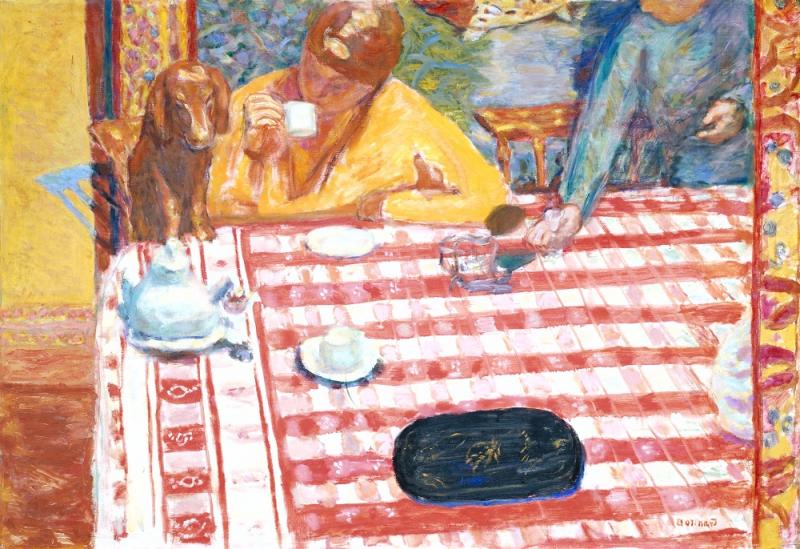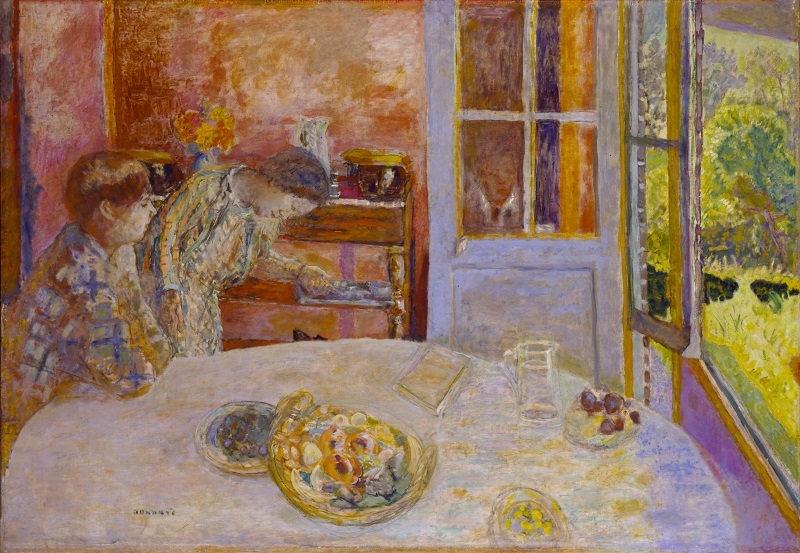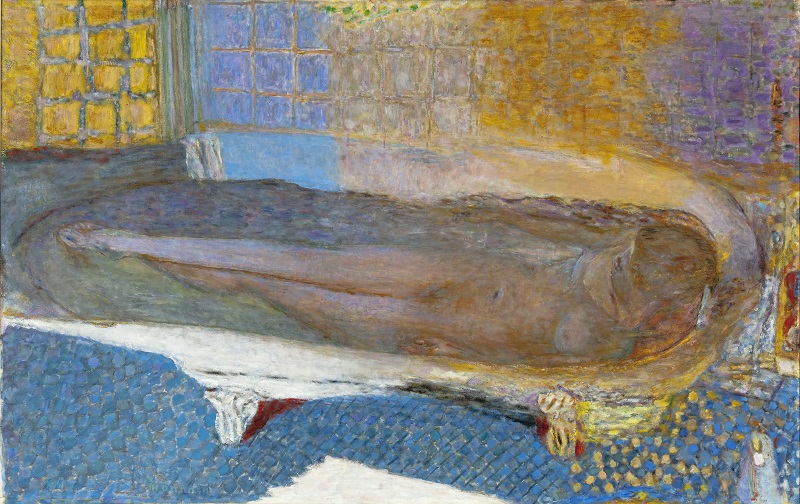Pierre Bonnard: The Colour of Memory review, Tate Modern - plenty but empty | reviews, news & interviews
Pierre Bonnard: The Colour of Memory review, Tate Modern - plenty but empty
Pierre Bonnard: The Colour of Memory review, Tate Modern - plenty but empty
A major retrospective of the French post-impressionist is huge, but unilluminating

“Slow looking” is the phrase du jour at Tate Modern, an enjoinder flatly contradicted by the extent of this exhibition, which in the history of the gallery’s supersized shows counts as a blow-out.
It’s not just that it sets ludicrous expectations about the amount of looking to be done in one hit: somewhere in this endless assault by colour is a note linking Bonnard’s reliable market value to his cheerful, easy-on-the-eye palette. Bonnard himself warned of the potential for dissonance between colour and meaning when he remarked, “He who sings is not always happy”, and this stack of around 100 paintings is a fulsome invitation to wallow aimlessly in colour. Implicit is the expectation that we will do no more than merrily skate over the surface, which does nothing to advance the thorough reassessment that such a significant survey ought to entail.
Spanning the years from 1900 until the artist’s death in 1947, Bonnard: The Colour of Memory deals with landscapes and domestic scenes, portraits and still-lifes that zing with colours fresh from the artist’s imagination. For all their ubiquity, Bonnard’s laden tables and views through windows are painted not from life, but from memory. Strange crops and viewpoints and vivid colours give them a dreamlike quality, veiled in emotion that is fine-tuned and concentrated in the remembering. At the beginning of the exhibition, we are encouraged to think of Bonnard’s as an essentially photographic way of seeing. Tiny prints of nude women, or of family groups, with figures sometimes sharp and sometimes blurred with movement, are snapshots even when posed. They coincide with the sudden advent of amateur photography, made possible in 1895 when Kodak launched a handheld camera that was not only easy to carry about, but that supported home printing once the negatives had been processed. Figures tumble towards the camera, sometimes at the edges of a frame, sometimes aware that they are being photographed, at other times not, qualities that find their way into Bonnard’s paintings, too.
At the beginning of the exhibition, we are encouraged to think of Bonnard’s as an essentially photographic way of seeing. Tiny prints of nude women, or of family groups, with figures sometimes sharp and sometimes blurred with movement, are snapshots even when posed. They coincide with the sudden advent of amateur photography, made possible in 1895 when Kodak launched a handheld camera that was not only easy to carry about, but that supported home printing once the negatives had been processed. Figures tumble towards the camera, sometimes at the edges of a frame, sometimes aware that they are being photographed, at other times not, qualities that find their way into Bonnard’s paintings, too.
The composition and high viewpoint of Coffee, 1915 (main picture), suggests a photograph, hastily taken – taken in passing, even. We might recognise the woman drinking coffee as the subject, but she is squeezed into a narrow space at the top of the canvas, in striking contrast to the great expanse of tablecloth that extends into the foreground. A woman’s arm reaches across the table, her head almost completely cut off, her hand slightly blurred with movement as it places or removes a something that might be a glass.
Elsewhere, it is not only the compositional idiosyncracies of the camera that interest Bonnard, but the act of mediated looking. Mirror Above a Washstand, 1908, was painted some years before the onset of his consuming interest in colour, and in a palette of greys and blues he creates a picture within a picture, the nude subject of the painting seen reflected in a mirror, her figure cropped in a way that recalls a view through a lens.
The comparison with Bonnard’s friend Monet also provides some insight into Bonnard’s artistic motives. Monet observed scenes obsessively, painting them at different points in the day and year to record the effects of changing light. Bonnard also returned to favourite subjects, particularly the view from the dining room onto the garden of his Normandy holiday home (pictured above: The Dining Room, Vernon c.1925). But Bonnard was not looking for lengthening shadows, or colours mixed in sunlight and rain, but rather the recollection of these things, tempered by the melancholy of time lost. This is not to say he was not acutely observant. But in the marking of time, Bonnard’s observations are made with a chilly detachment that subjects his models, particularly Marthe de Méligny, his long-term partner and eventually his wife. In Room 11, time and again Marthe is the model for large-scale paintings of bathers: sometimes she is in the bath, sometimes out of it; in one painting she leans against the bath edge, lost in thought, Bonnard’s by now familiar high viewpoint emphasising the very evident power imbalance between them. There’s nothing erotic about Marthe’s baths – she took them as part of a therapeutic regime prescribed to alleviate a battery of mysterious illnesses. At times Bonnard’s relentless looking at her seems almost sadistic – there is no question of these paintings serving as portraits, and though we see her body often, as a woman she becomes no more familiar to us.
This is not to say he was not acutely observant. But in the marking of time, Bonnard’s observations are made with a chilly detachment that subjects his models, particularly Marthe de Méligny, his long-term partner and eventually his wife. In Room 11, time and again Marthe is the model for large-scale paintings of bathers: sometimes she is in the bath, sometimes out of it; in one painting she leans against the bath edge, lost in thought, Bonnard’s by now familiar high viewpoint emphasising the very evident power imbalance between them. There’s nothing erotic about Marthe’s baths – she took them as part of a therapeutic regime prescribed to alleviate a battery of mysterious illnesses. At times Bonnard’s relentless looking at her seems almost sadistic – there is no question of these paintings serving as portraits, and though we see her body often, as a woman she becomes no more familiar to us.
In Nude in the Bath, 1936-8, Marthe is barely there, her head rendered in the same murky blue as the water. Elsewhere, as in Nude in an Interior, c. 1935, she is no more than a decorative element in a visually exciting composition, half seen – hiding, it is tempting to think. In among these scenes of Marthe in her chilly bathroom, Bonnard’s self-portrait appears, reflected in the bathroom mirror. His world is revealed as limited and joyless, and though his work can at times be beautiful, or exciting, or clever, it never seems to resolve – if clarity comes from this enormous collection of paintings, it is that Bonnard reiterates without progress.
- Pierre Bonnard: The Colour of Memory at Tate Modern until 6 May
- Read more visual arts reviews on theartsdesk
rating
Explore topics
Share this article
Add comment
The future of Arts Journalism
You can stop theartsdesk.com closing!
We urgently need financing to survive. Our fundraising drive has thus far raised £49,000 but we need to reach £100,000 or we will be forced to close. Please contribute here: https://gofund.me/c3f6033d
And if you can forward this information to anyone who might assist, we’d be grateful.

Subscribe to theartsdesk.com
Thank you for continuing to read our work on theartsdesk.com. For unlimited access to every article in its entirety, including our archive of more than 15,000 pieces, we're asking for £5 per month or £40 per year. We feel it's a very good deal, and hope you do too.
To take a subscription now simply click here.
And if you're looking for that extra gift for a friend or family member, why not treat them to a theartsdesk.com gift subscription?
more Visual arts
 'We are bowled over!' Thank you for your messages of love and support
Much-appreciated words of commendation from readers and the cultural community
'We are bowled over!' Thank you for your messages of love and support
Much-appreciated words of commendation from readers and the cultural community
![SEX MONEY RACE RELIGION [2016] by Gilbert and George. Installation shot of Gilbert & George 21ST CENTURY PICTURES Hayward Gallery](https://theartsdesk.com/sites/default/files/styles/thumbnail/public/mastimages/Gilbert%20%26%20George_%2021ST%20CENTURY%20PICTURES.%20SEX%20MONEY%20RACE%20RELIGION%20%5B2016%5D.%20Photo_%20Mark%20Blower.%20Courtesy%20of%20the%20Gilbert%20%26%20George%20and%20the%20Hayward%20Gallery._0.jpg?itok=7tVsLyR-) Gilbert & George, 21st Century Pictures, Hayward Gallery review - brash, bright and not so beautiful
The couple's coloured photomontages shout louder than ever, causing sensory overload
Gilbert & George, 21st Century Pictures, Hayward Gallery review - brash, bright and not so beautiful
The couple's coloured photomontages shout louder than ever, causing sensory overload
 Lee Miller, Tate Britain review - an extraordinary career that remains an enigma
Fashion photographer, artist or war reporter; will the real Lee Miller please step forward?
Lee Miller, Tate Britain review - an extraordinary career that remains an enigma
Fashion photographer, artist or war reporter; will the real Lee Miller please step forward?
 Kerry James Marshall: The Histories, Royal Academy review - a triumphant celebration of blackness
Room after room of glorious paintings
Kerry James Marshall: The Histories, Royal Academy review - a triumphant celebration of blackness
Room after room of glorious paintings
 Folkestone Triennial 2025 - landscape, seascape, art lovers' escape
Locally rooted festival brings home many but not all global concerns
Folkestone Triennial 2025 - landscape, seascape, art lovers' escape
Locally rooted festival brings home many but not all global concerns
 Sir Brian Clarke (1953-2025) - a personal tribute
Remembering an artist with a gift for the transcendent
Sir Brian Clarke (1953-2025) - a personal tribute
Remembering an artist with a gift for the transcendent
 Emily Kam Kngwarray, Tate Modern review - glimpses of another world
Pictures that are an affirmation of belonging
Emily Kam Kngwarray, Tate Modern review - glimpses of another world
Pictures that are an affirmation of belonging
 Kiefer / Van Gogh, Royal Academy review - a pairing of opposites
Small scale intensity meets large scale melodrama
Kiefer / Van Gogh, Royal Academy review - a pairing of opposites
Small scale intensity meets large scale melodrama
 Jenny Saville: The Anatomy of Painting, National Portrait Gallery review - a protégé losing her way
A brilliant painter in search of a worthwhile subject
Jenny Saville: The Anatomy of Painting, National Portrait Gallery review - a protégé losing her way
A brilliant painter in search of a worthwhile subject
 Abstract Erotic, Courtauld Gallery review - sculpture that is sensuous, funny and subversive
Testing the boundaries of good taste, and winning
Abstract Erotic, Courtauld Gallery review - sculpture that is sensuous, funny and subversive
Testing the boundaries of good taste, and winning
 Edward Burra, Tate Britain review - watercolour made mainstream
Social satire with a nasty bite
Edward Burra, Tate Britain review - watercolour made mainstream
Social satire with a nasty bite
 Ithell Colquhoun, Tate Britain review - revelations of a weird and wonderful world
Emanations from the unconscious
Ithell Colquhoun, Tate Britain review - revelations of a weird and wonderful world
Emanations from the unconscious

Comments
Not the same show I saw. A
Likewise. Perhaps art